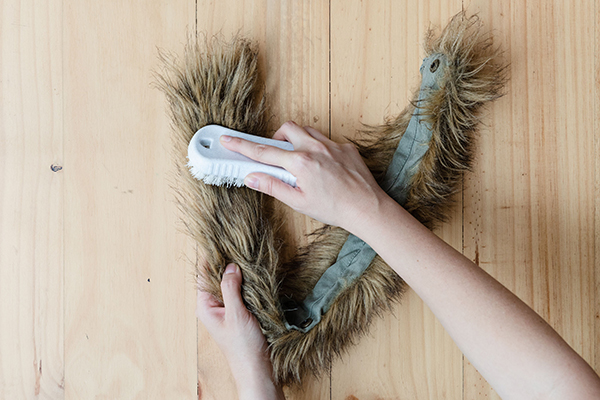Sooner or later, fur owners come to the conclusion that things need to be cleaned. And here several questions arise — how to wash fur, can it be done at all, can a washing machine be used for this, or is it necessary to use only hand washing? Let’s start with the fact that expensive items made of natural or artificial material are recommended to be dry-cleaned, their processing should be carried out only by professionals who have the skills, experience, specialized cleaning products and equipment. If you wash a fur coat, short fur coat, vest at home, they can become deformed and shrink. If it is not possible to take the product to dry cleaning, you can try dry cleaning at home, later in the article we will dwell on this topic in more detail. Collars, detachable cuffs, natural fur trim can be washed by hand or in a washing machine. However, you must strictly observe the correct washing technique so as not to spoil the thing. It’s better not to risk it and trust the professionals, but if you prefer doing your own laundry, we will tell you how to do it as safely as possible. Regarding faux fur products, they can be safely washed both in an automatic type machine and manually. Manufacturers of such clothes just focus the attention of consumers on the fact that their products are compatible with machine wash.

How to wash real fur by hand
Experts once again warn, wash products made of natural fur only if you are confident in your abilities. So, the sequence of actions:
-
We unfasten metal elements, decor details, inserts, in general, everything solid that can be removed from the object.
-
We collect warm water in the washing container, dilute in it a specialized detergent for washing delicate fabrics, or better, baby shampoo, the best option is animal shampoo (veterinary). The last remedy is best, since in theory it does not contain aggressive chemicals that have a negative effect on fatty protection, if it disappears, the base (mezdra) will loosen, the villi will begin to fall out. After pouring the shampoo, beat the foam with your hands.
-
Immerse the item in water. We don’t wrinkle, we don’t press, but only with light movements we stroke the fur, wipe it in the direction of pile growth.
-
Gently comb the fur using a brush with rare teeth.
-
We take out the product of their soapy water, collect new water, add a few tablespoons of ordinary 9% vinegar to it. Immerse the thing in water, let it lie down for 2–3 minutes.
-
We change the water again, this time we pour cold water, since rinsing is recommended at low temperatures, because cold water closes the hair scales, as a result, the fur will shine after drying. You need to rinse the product in as many changes of water as necessary, so that as a result the water is completely transparent and without a hint of foam.
-
Carefully wring out the thing with your hands, do not twist.
It is recommended to dry natural fur on a flat surface, in a horizontal position, after laying a terry towel under it. Drying should take place in a ventilated room with well-circulated air, away from heat sources (including it is strictly forbidden to use a hair dryer to speed up drying). There should be no strong-smelling objects around, otherwise the smell may be absorbed into the fur. After the thing has dried completely, gently comb the pile, moving in the direction of its growth.
Washing in a washing machine
Washing real fur in the washing machine is even more risky than washing by hand. But if you decide on this, there is nothing complicated in the procedure. We set the most delicate mode on the panel of the machine — for silk and wool or down products. Or you can simply set the temperature to 30–40 degrees, the processing time is 30 minutes, without spinning, it is possible with an additional rinse. We place the product in a special mesh or a fabric bag made of white cotton fabric, load it into the machine (we do not wash any other things at the same time as the fur). After the process is completed, we wring out the product, straighten it, let it dry on a terry towel.
Features of washing products from different types of natural fur
Let’s dwell on how to wash or clean clothes made from the fur of different animals. Features of the procedure:
-
Rabbit. Before washing, always make sure that the product is in good condition and will withstand the cleaning procedure. To do this, pinch a small bundle of wool in your fingers, pull it slightly. If there are a lot of hairs left in your hands, then you cannot wash the product yourself, it is better to take it to professionals. Everything else is standard. -
arctic fox. Such products are strictly not recommended to be washed either in a typewriter or by hand. The inside of the thing should not get wet. It may come into contact with water a little, but a significant ingress of moisture to the area near the roots of the villi and to the inside of the product is detrimental to it. Therefore, in order to somehow clean the product, restore shine and volume, you can carry out dry or wet cleaning. Dry is done with talcum powder or crushed clerical chalk. The product is laid out, sprinkled with absorbent, it must be washed, then shaken and combed with a brush. To obtain the desired result, you may have to repeat the procedure up to 3–4 times. Wet cleaning is carried out with plain water, water and ammonia, water and shampoo. Pour any of the listed mixtures into a spray bottle, spray the product onto the fur so that it becomes wet, but not wet, wipe the pile with a cotton or gauze swab. After that, you can take new tampons, moisten them with clean cool water and wipe until completely cleansed of the detergent. -
Raccoon. Such fur, as well as fox fur, is extremely demanding to care for and incredibly difficult to clean. It must be dry cleaned using grated chalk or talcum powder. It can also be wiped with a damp swab, but only on top. During the cleaning procedure and in the process of drying, the raccoon fur must be constantly combed using a hard brush with metal teeth, since the density of the raccoon pile is increased. -
Fox. Experts also do not recommend washing products made from the fur of this animal, since moisture should not fall on the mezra. Acceptable cleaning methods are dry and wet, by wiping the fur with a solution of water and pet shampoo.
Dry cleaning

Obviously, most fur items cannot be washed in the classical sense of the word. And if some things can be washed, then professionals should do it, home processing can lead to damage to the product. However, you can still clean clothes with dry or semi-dry cleaning methods. Above, we already wrote that for this you can use chalk and talc, shampoo diluted in water for dogs. Consider what other means can be used for such purposes. But first, advice — before you start cleaning, shake the product well, knock out the dust from it, vacuum it using a special nozzle for upholstered furniture.
Additional products for dry and semi-dry cleaning of fur items (it is better to carry out the procedure in the open air or in the bathroom, so that you do not have to carry out a general cleaning of the premises later):
-
Flour.
-
Grinded oatmeal in a blender or coffee grinder, meat grinder.
-
Water with hydrogen peroxide.
-
Sand.
-
Starch.
-
Small sawdust.
Keep in mind that food products (flour, oatmeal, etc.) used in cleaning may attract the attention of insects, in particular moths. If such an improvised cleaning agent is not completely removed from the pile, insects can damage both the core and the pile.
How to clean natural fur from yellowness
Over time, the fur on the product may turn yellow. This does not add to the attractiveness of the thing, so many owners of fur clothes try to return the natural color to the pile. This can be done using a tool that is prepared according to a simple recipe — mix in half a glass of water one tablespoon of ordinary table salt and half a tablespoon of ammonia (we work in a respirator so that the smell of ammonia does not irritate). Then we take a soft cloth, preferably white cotton, dip it into the solution and wring it well, it should remain barely damp. We wipe the fur with a cloth, especially carefully treating the yellowed areas. In this way, we remove greasy contaminants that give the fur an ugly shade. After that, shake the fur product, straighten the villi, leave to dry.
Expert Tips
Experts in the field of fur care give several recommendations to help you carry out the cleaning procedure efficiently and safely:
-
Never use dry detergents for washing. Also do not use any household or homemade stain removers or bleaches.
-
Never twist wet fur things, as you harm both the core and the pile.
-
Fur should not be dried in the sun or near heating appliances.
Well, the last recommendation — the fur is never ironed, even from the inside out, so you should not do this either.
How to wash faux fur

Synthetic fur products are washed by hand in the same way as things made from natural materials. Washing in a machine on a delicate cycle is also allowed, but only if the length of the pile does not exceed three to four centimeters. You can dry clothes in the standard way — on a horizontal surface, on a terry towel, in a room that is well ventilated.
When is the best time to call the professionals?
Of course, experts recommend contacting a dry cleaner whenever you need to wash or otherwise clean a product made of natural fur, especially such expensive species as arctic fox, mink. But if your clothes are heavily soiled, you can’t do without the services of professional dry cleaners. When to contact the experts:
-
If the clothes have dirty smudges from precipitation (snow, rain).
-
If on the product, especially on the hem, there are traces of reactive salts that public utilities sprinkle roads and sidewalks in winter.
-
If things have stains of unknown origin, traces of cosmetics and other foreign substances.
-
If the product is heavily soiled, it cannot be cleaned by yourself at home.
Experts advise to dry-clean clothes made of fur at least once a year, the optimal time is spring. Professional cleaning will not only restore the aesthetic and attractive appearance of the product, but also prevent the occurrence of moths, which, as you know, can easily ruin the most expensive fur product. The cost of dry-cleaning things made of natural or artificial material depends on several factors, in particular, the location of the company, its reputation, the length of the thing and the complexity of its cut, on average it is about 50 dollars. But, you see, a fur coat or other product costs much more, it is better to pay for professional care than to ruin the thing and face the need to buy a new one.

Добавить комментарий
Для отправки комментария вам необходимо авторизоваться.